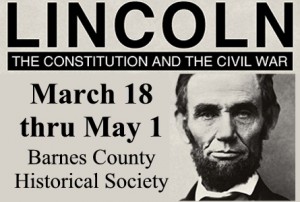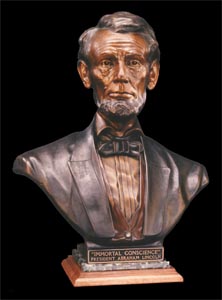“Lincoln: The Constitution and the Civil War.” a national traveling exhibition, is now at the Barnes County Historical Society through May 1. Interview with Wes Anderson as aired on “City Matters Special Edition” – CSi TV 10 .
Video: CSi TV 10 The Replay Channel
It examines how President Lincoln used the Constitution to confront three intertwined crises of the Civil War—the secession of Southern states, slavery and wartime civil liberties.
Lincoln is widely acknowledged as one of America’s greatest presidents, but his historical reputation is contested. Was he a calculating politician willing to accommodate slavery, or a principled leader justly celebrated as the Great Emancipator?
 This exhibition provides no easy answers. Rather, it encourages visitors to form a nuanced view of Lincoln by engaging them with Lincoln’s struggle to reconcile his policy preferences with basic American ideals of liberty and equality. This exhibition develops a more complete understanding of Abraham Lincoln as president and the Civil War as the nation’s gravest constitutional crisis.
This exhibition provides no easy answers. Rather, it encourages visitors to form a nuanced view of Lincoln by engaging them with Lincoln’s struggle to reconcile his policy preferences with basic American ideals of liberty and equality. This exhibition develops a more complete understanding of Abraham Lincoln as president and the Civil War as the nation’s gravest constitutional crisis.
Abraham Lincoln was elected President of the United States in 1860, at a time when the nation was on the brink of war. Lincoln struggled to resolve the basic questions that divided Americans at the most perilous moment in the nation’s history: Was the United States truly one nation, or was it a confederacy of sovereign and separate states? How could a country founded on the belief that “all men are created equal” tolerate slavery? In a national crisis, would civil liberties be secure? President Lincoln used the Constitution to confront these three crises of war, ultimately reinventing the Constitution and the promise of American life.
“We are delighted to have been selected as a site for this exhibition,” said Museum Curator Wes Anderson. “As a new president, Abraham Lincoln was faced with enormous challenges. This exhibition shows how Lincoln struggled with issues of secession, slavery and civil liberties—all questions our country’s founding charter left unanswered. Each section of the exhibit features information about a different aspect of Lincoln’s presidency. For example, the section about slavery examines the various policy options Lincoln once embraced and how his thoughts about slavery evolved over time. Most importantly, the exhibit helps visitors understand why Lincoln’s struggle with the Constitution still matters today.”
 The National Constitution Center and the American Library Association Public Programs Office organized the traveling exhibition, which was made possible by a major grant from the National Endowment for the Humanities (NEH): great ideas brought to life. The traveling exhibition is based on an exhibition of the same name developed by the National Constitution Center.
The National Constitution Center and the American Library Association Public Programs Office organized the traveling exhibition, which was made possible by a major grant from the National Endowment for the Humanities (NEH): great ideas brought to life. The traveling exhibition is based on an exhibition of the same name developed by the National Constitution Center.
The traveling exhibition is composed of informative panels featuring photographic reproductions of original documents, including a draft of Lincoln’s first inaugural speech, the Emancipation Proclamation and the Thirteenth Amendment.
The museum is sponsoring free programs and other events for the public in connection with the exhibition. Contact 701-845-0966, via email: wes_anderson75@hotmail.com, or check us out on Facebook for more information.
“Lincoln: The Constitution and the Civil War” will be on display at the museum until May 1st, 2015.
















Comments are closed
Sorry, but you cannot leave a comment for this post.